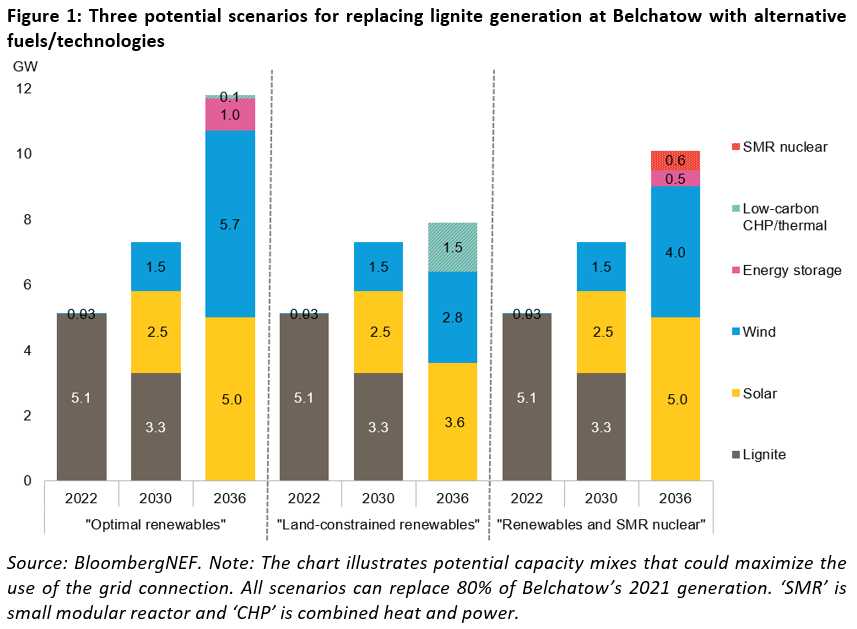A new BloombergNEF report suggests that Europe’s largest coal-fired power plant could replace most of its lignite generation with renewable energy, paired with batteries or a lower-carbon thermal capacity.
Transitioning the coal-fired power plant to a lower carbon emissions option would decrease overall power system costs in the Łódź region of Poland, while maintaining critical energy security.
The Belchatow power station is the sixth largest coal-fired power plant in the world. As such, it currently it is playing a vital role in the central European energy grid.
The BNEF report finds that deploying 11GW of wind and solar in the region to replace 80% of Belchatow’s brown coal generation is possible from a land-use perspective. Alternatively, some 6GW of wind and solar paired with a gas, biomass or waste-to-energy plant could achieve similar output.
Its analysis examines the feasibility of deploying lower-carbon technologies and offers a possible transition roadmap to do so. The report was released last week by Bloomberg Philanthropies and BNEF in partnership with Forum Energii at an event in the Polish region of Łódź where the Belchatow plant stands.
Replacing coal-fired power plant could create example for whole world
Michael Bloomberg, UN Secretary-General’s Special Envoy on Climate Ambition and Solutions and founder of Bloomberg LP and Bloomberg Philanthropies, said that as the effects of climate change worsen, Europe’s energy crisis and Russia’s invasion of Ukraine only underscore countries’ urgent need to choose clean energy and cut their reliance on fossil fuels.
“This new report shows a promising path to replacing Europe’s biggest coal-fired power plant with alternative and resilient clean energy sources – and it can serve as an example for coal regions in Europe and globally that are looking to reap the health and economic benefits of clean energy.”
Belchatow supplies a fifth of Poland’s power and sits at the heart of the Polish power system and energy security. The successful transition of this coal-fired power plant could serve as an example for coal-regions around the world.

Joanna Maćkowiak-Pandera, CEO of Forum Energii, said the construction of new, low-emission sources in the Bełchatów region must be started as soon as possible in order to maintain the security of energy supply at a high level and reduce electricity prices.
“Lignite resources in Belchatow are limited in time and will run out soon. This report proposes options for replacing generation with clean capacity that will ensure Poland’s security of supply,” said Maćkowiak-Pandera.
Maciej Kozakiewicz, Plenipotentiary of the Board of the Łódź Province for the transformation of the Belchatow region, called the BNEF report optimistic about Belchatow’s energy future.
“It proves that with the involvement of all stakeholders, the region’s prosperity can still be built on energy generation. The realisation of such a scenario requires full mobilization around constructive scenarios, but it clearly shows how the energy of both activities and generation should be directed,” said Kozakiewicz.
Creating localised energy security
BNEF also finds that very little new generation capacity is currently planned for the Łódź region. The current lack of transition plans for replacing lignite puts Poland’s energy security at risk and could see valuable grid infrastructure around Belchatow become stranded.
BNEF’s analysis presents several alternatives for replacing the decline in lignite generation at Belchatow alongside wind and solar, including thermal plants such as gas, biomass or waste-to-energy. However, fuel availability and price would limit the feasible size of thermal plants.
While Poland is expanding its import capacity for liquefied natural gas to make up for lost imports from Russia, securing investments for a new gas pipeline to Belchatow could be challenging in the current market environment. Nuclear is unlikely to replace lost lignite generation on time as new capacity often takes more than 10 years to plan and build.
Concrete plans to prepare for Belchatow’s retirement and accelerate the deployment of new low-carbon capacity could open the door for the plant to benefit from Just Transition funding from the EU.
Poland has the potential to receive around €3.5 billion ($3.4bn) to support five of its region’s transition away from coal by 2030. The funds would create reskilling and economic opportunities to boost the country’s economy.